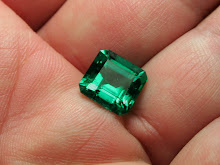Pure gold is rated as 24 karat. Alloys that are less than pure are rated with a karat rating proportional to the percent of pure gold in the alloy. For example a gold alloy that is 75% pure is rated with a value that is 75% of what is considered pure. So in this case, it’s 18 karat. Taking it further, you can calculate that 14 karat gold is approximately 58% pure. If you learned something from that explanation, you’re probably wondering… why not use pure gold? and what makes up the other percentage?
Jewelers use pure gold less often to make a complete piece because of 3 main reasons. A) Using 24kt gold makes the piece much more expensive. B) The color of pure gold is a bit too much for most people’s taste. It needs to be lightened up a bit. C) Pure gold is softer than the mixed alloys. That isn’t to say that it’s not hard. It’s still a metal, but it will be perhaps more susceptible to nicks, scratches, and dings.
Now that you understand the ‘why’, here’s what you’re probably more interested in knowing… Gold alloys that are less than 24 karat are mixed with other pure metals to physically harden it up and to soften its color. In the case of yellow gold, silver and copper is used. For white gold alloys, silver and palladium is what the recipe calls for. Different jewelers might add these metals in slightly different amounts, but the amount added in relation to the amount of gold used will determine the final karat rating. The mixture Embassy Emeralds uses for 18kt white gold is 10 grams 24kt gold alloyed with 1.65 grams each of both silver and palladium. When you do the math, you come up with 13.3 grams of 18kt gold, or a 75% pure alloy. The same amounts are used in the yellow gold recipe, but with pure copper used instead of palladium.
Some jewelers will take a cheaper path. They’ll use nickel and zinc in their alloys instead of the more expensive metals called for to make it a quality alloy. There are two big drawbacks to doing this and they mostly impact the end customer…. A) These cheaper metals are the ones that tend to cause allergic reactions and irritations. The reason pure gold, silver, platinum, palladium, and copper is used is due to their very low reactivity with other elements. If they don’t react with anything, they can’t oxidize easily or cause irritation. B) The alloy becomes brittle and difficult to work with after a while. Since the jeweler’s taking the cheap route, he’s also probably casting the piece instead of working the metal by hand. He’s not concerned about it, but imagine the customer who needs a resize or breaks a prong on a setting. It’s going to be a lot more difficult to work with.
With the rising price of gold, we can probably expect more of this in the market. It's unfortunate, but it's either that or significant price increases which have already begun industry wide as jewelers struggle to keep their revenues up enough to stay in line with the gold price increases and be able to afford new merchandise.
As you can see, there is more to your gold jewelry than you thought. But you shouldn’t have to think about it. It should be the quality you expect and not give you problems. Embassy Emeralds makes all of its gold jewelry in 18kt. We find it to be of excellent quality and appearance and ideal for most jewelry applications. We will however take requests to work in 14kt or 22kt gold on custom pieces.
Monday, March 3, 2008
A Lesson on Gold
Posted by
www.embassyemeralds.com
at
12:31 AM
0
comments
![]()
Labels: Custom Jewelry, gold, Jewelry
Share it! Digg
Digg
 del.icio.us
del.icio.us  Reddit
Reddit
 StumbleUpon
StumbleUpon
 Fark
Fark  Technorati
Technorati
 Netscape
Netscape
 Furl
Furl
Subscribe to:
Posts (Atom)


